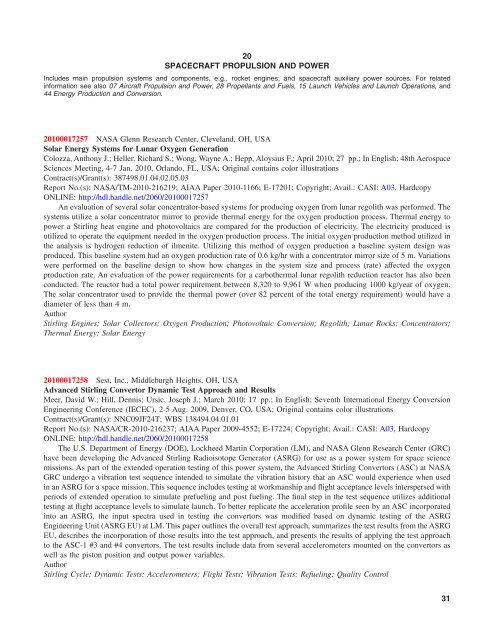NASA Scientific and Technical Aerospace Reports - The University ...
NASA Scientific and Technical Aerospace Reports - The University ...
NASA Scientific and Technical Aerospace Reports - The University ...
You also want an ePaper? Increase the reach of your titles
YUMPU automatically turns print PDFs into web optimized ePapers that Google loves.
20<br />
SPACECRAFT PROPULSION AND POWER<br />
Includes main propulsion systems <strong>and</strong> components, e.g., rocket engines; <strong>and</strong> spacecraft auxiliary power sources. For related<br />
information see also 07 Aircraft Propulsion <strong>and</strong> Power, 28 Propellants <strong>and</strong> Fuels, 15 Launch Vehicles <strong>and</strong> Launch Operations, <strong>and</strong><br />
44 Energy Production <strong>and</strong> Conversion.<br />
20100017257 <strong>NASA</strong> Glenn Research Center, Clevel<strong>and</strong>, OH, USA<br />
Solar Energy Systems for Lunar Oxygen Generation<br />
Colozza, Anthony J.; Heller, Richard S.; Wong, Wayne A.; Hepp, Aloysius F.; April 2010; 27 pp.; In English; 48th <strong>Aerospace</strong><br />
Sciences Meeting, 4-7 Jan. 2010, Orl<strong>and</strong>o, FL, USA; Original contains color illustrations<br />
Contract(s)/Grant(s): 387498.01.04.02.05.03<br />
Report No.(s): <strong>NASA</strong>/TM-2010-216219; AIAA Paper 2010-1166; E-17201; Copyright; Avail.: CASI: A03, Hardcopy<br />
ONLINE: http://hdl.h<strong>and</strong>le.net/2060/20100017257<br />
An evaluation of several solar concentrator-based systems for producing oxygen from lunar regolith was performed. <strong>The</strong><br />
systems utilize a solar concentrator mirror to provide thermal energy for the oxygen production process. <strong>The</strong>rmal energy to<br />
power a Stirling heat engine <strong>and</strong> photovoltaics are compared for the production of electricity. <strong>The</strong> electricity produced is<br />
utilized to operate the equipment needed in the oxygen production process. <strong>The</strong> initial oxygen production method utilized in<br />
the analysis is hydrogen reduction of ilmenite. Utilizing this method of oxygen production a baseline system design was<br />
produced. This baseline system had an oxygen production rate of 0.6 kg/hr with a concentrator mirror size of 5 m. Variations<br />
were performed on the baseline design to show how changes in the system size <strong>and</strong> process (rate) affected the oxygen<br />
production rate. An evaluation of the power requirements for a carbothermal lunar regolith reduction reactor has also been<br />
conducted. <strong>The</strong> reactor had a total power requirement between 8,320 to 9,961 W when producing 1000 kg/year of oxygen.<br />
<strong>The</strong> solar concentrator used to provide the thermal power (over 82 percent of the total energy requirement) would have a<br />
diameter of less than 4 m.<br />
Author<br />
Stirling Engines; Solar Collectors; Oxygen Production; Photovoltaic Conversion; Regolith; Lunar Rocks; Concentrators;<br />
<strong>The</strong>rmal Energy; Solar Energy<br />
20100017258 Sest, Inc., Middleburgh Heights, OH, USA<br />
Advanced Stirling Convertor Dynamic Test Approach <strong>and</strong> Results<br />
Meer, David W.; Hill, Dennis; Ursic, Joseph J.; March 2010; 17 pp.; In English; Seventh International Energy Conversion<br />
Engineering Conference (IECEC), 2-5 Aug. 2009, Denver, CO, USA; Original contains color illustrations<br />
Contract(s)/Grant(s): NNC09JF24T; WBS 138494.04.01.01<br />
Report No.(s): <strong>NASA</strong>/CR-2010-216237; AIAA Paper 2009-4552; E-17224; Copyright; Avail.: CASI: A03, Hardcopy<br />
ONLINE: http://hdl.h<strong>and</strong>le.net/2060/20100017258<br />
<strong>The</strong> U.S. Department of Energy (DOE), Lockheed Martin Corporation (LM), <strong>and</strong> <strong>NASA</strong> Glenn Research Center (GRC)<br />
have been developing the Advanced Stirling Radioisotope Generator (ASRG) for use as a power system for space science<br />
missions. As part of the extended operation testing of this power system, the Advanced Stirling Convertors (ASC) at <strong>NASA</strong><br />
GRC undergo a vibration test sequence intended to simulate the vibration history that an ASC would experience when used<br />
in an ASRG for a space mission. This sequence includes testing at workmanship <strong>and</strong> flight acceptance levels interspersed with<br />
periods of extended operation to simulate prefueling <strong>and</strong> post fueling. <strong>The</strong> final step in the test sequence utilizes additional<br />
testing at flight acceptance levels to simulate launch. To better replicate the acceleration profile seen by an ASC incorporated<br />
into an ASRG, the input spectra used in testing the convertors was modified based on dynamic testing of the ASRG<br />
Engineering Unit (ASRG EU) at LM. This paper outlines the overall test approach, summarizes the test results from the ASRG<br />
EU, describes the incorporation of those results into the test approach, <strong>and</strong> presents the results of applying the test approach<br />
to the ASC-1 #3 <strong>and</strong> #4 convertors. <strong>The</strong> test results include data from several accelerometers mounted on the convertors as<br />
well as the piston position <strong>and</strong> output power variables.<br />
Author<br />
Stirling Cycle; Dynamic Tests; Accelerometers; Flight Tests; Vibration Tests; Refueling; Quality Control<br />
31

















